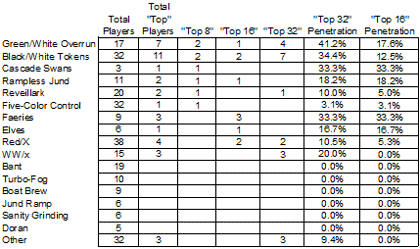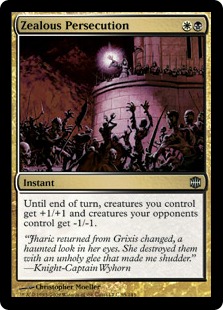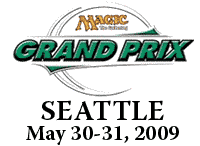Old-school Chicago Pro Ronny Serio put it well:
“So, Adrian… Months of playtesting thrown aside for a last-minute Japanese deck?”
Yeah. Yeah, yeah, yeah. Like nine other players, I slung up my version of the Tokyo-championship Turbo-Fog deck. Like nine other players, I did not make the Top 32 of the 270 person Chicago Regionals, let alone come close to qualifying. I’m still not 100% sure, but I think I’d sleeve up the same deck again, even if I failed to recognize just how risky that was going to be.
Some might wonder, “Why play Turbo-Fog?” It’s true that historically the deck hasn’t quite gotten there, but we don’t live in a world of history. We live in a world that is certainly best understood when informed by history, but the world we live in is in constant flux. Turbo-Fog was so absolutely devastating for Black/White Tokens and even, shockingly, devastating for every deck that I played it against packing Cryptic Commands (sans Faeries), that it just seemed silly not to play with the deck.
One of the things that is sometimes worth thinking about is just how regional a metagame can be. Chicago, for those of you not in the know, is historically a land in love with BURN. It’s been like that for years and years and years. With the printing of Anathemancer and Bloodbraid Elf, it is no surprise that a ton of people came slinging Red-based aggressive decks, some with Blightning, some mono-Red, some Black/Red, some packing the whole “Jund” package. Giving a Red-based deck a Howling Mine — well, let’s just say that that is a rough one. I know that I can beat a Red deck with Turbo-Fog; I’ve done it. That said, I’m willing to bet that the average chances are quite, quite low.
The full Chicago metagame (my thanks to Pastimes head judge Michael Zimmerman for access to all of the data) broke down like this:
Red-X Aggro: 38
Five-Color Control (and Cascade/Planeswalker variants): 32
Black/White Token (non-WW): 32
Reveillark: 20
Bant Aggro: 19
Green/White Overrun: 17
Kithkin/x: 15
“Rampless” Jund: 11
Turbo-Fog: 10
Faeries: 9
Boat Brew: 9
Elves: 6
Jund Ramp: 6
Sanity Grinding: 6
Doran: 5
Other: 35
I think a big part of my problem was that I ended up in Chicago rather than in, say, Minneapolis, for the Legions Events Regionals tournament. While I’m confident that Red/x aggressive decks would have existed up on the top end, I’m also confident it would have been far closer to the Bant numbers.
That “Other” category is for any archetype that had less than five players. There were certainly a lot of them. Regionals is like that, though, with people bringing all kinds of decks to game with. One of the things that is deeply unusual about this Regionals, though, is that it is running in the midst of a Standard PTQ season, and so the Regionals is actually a deeply vetted. In most Regionals, everyone is coming to the table with a lot less data, and Regionals is a format that most people are far less prepared for.
This is probably partly why Turbo-Fog did so well in Tokyo. The decks were a stage less developed, but the base metagame was still there: domination by Black/White Tokens. Alternate means of fighting the strategy were still more or less incubating. Fogging against Black/White Tokens is essentially a trivial exercise; there is little that they can do that matters. In a more developed metagame, other decks are going to be at or near the top as well, some of who can do well against Turbo-Fog.
The Upper portions of the field, represented by roughly the Top 10-15%, can be found by looking at the 18-20 point competitors, from 19th place to 38th. They were:
38 — Green/White Overrun
37 — Red (Blightning)
36 — Red (“Jund”)
35 — Kithkin
34 — Kithkin/Red
33 — Black/White Tokens
32 — Black/White Tokens
31 — Green/White Overrun
30 — Black/White Tokens
29 — Green/White Overrun
28 — Green/White Overrun
27 — Kithkin
26 — Martial Coup Control
25 — Elementals
24 — Blue/White/Green Control
23 — Black/White Tokens
22 — Black/White Tokens
21 — Reveillark
20 — Black/White Tokens
19 — Black/White Tokens
One of the things that is distinctly noticeable about this group is the sheer overwhelming representation of Windbrisk Heights. Between Green/White Overrun, Kithkin, and Black/White Tokens, that is 14 of 20 decks that are running Heights. Even among those that are not, fully half of them are also decks that are attacking.
The three “oddball” decks, Elementals, Martial Coup Control, and Blue/White/Green Control are all very, very off the radar. The Elementals deck looks something like the Block builds of the deck, replacing Crib Swap with Path to Exile, and using Horde of Notions as its primary finisher. The Martial Coup deck was a classic Red/White “blow-em up” Midrange Control deck, running a ton of Story Circles, Wraths, and point-and-click removal. The Blue/White/Green deck ran a few counterspells to hold the fort, and eventually killed with Knight of the Reliquary or Jenara, otherwise masquerading as some kind of Reveillark-looking (though it had no Reveillark) control deck.
The “Top 16” was made of those who didn’t tie for the Top 8 cutoff, all of whom had 7-2 records. They were:
18 — Green/White Overrun
17 — Red (“Rakdos”)
16 — Black/White Tokens
15 — Faeries
14 — Faeries
13 — Red (Bloodbraid-Blightning)
12 — Elves
11 — Black/White Tokens
10 — Jund Tokens
9 — Faeries
Suddenly, out of nowhere, come a slew of Faeries. The three Faeries players who made Top 16 were among the more tournament experienced players in the room, and they were definitely really close to making the Top 8. This is probably something that will be indicative of how Faeries will perform in the hands of the better players in a field — that is to say, such a player will probably be right on the bubble, but likely on the wrong side of it. I know that in the Boat Cruise Qualifier, Faeries met in the finals. It is important to note that the Boat Cruise was Qualifier was comprised of players that were not in contention for Regionals. Sam Black would win it with Faeries, but his play skill was so far above the competition, I don’t know if his victory had more to say about relative skill than deck choice.
Again, Black/White, Green/White, and Red continue to be represented, with only Brian Kowal’s oddball Jund Tokens deck otherwise in the running. Brian conceded to a friend to guarantee their making Top 8, though unfortunately that player, current Wisconsin State Champion Collin LaFleur, wasn’t able to win his matchup against Charles Hendricks. I know that I definitely consider a huge part of this to be my fault; I lost to Charles in three games, punting a match I definitely should have won if I wasn’t foolishly overconfident.
When we break down the Top 8 to their actual finishes, we have this:
8th — Michael Blanchard, Green/White Overrun
7th — Collin LaFleur, Reveillark
6th — Scott Alshanski, Rampless Jund
5th — Michael Bernat, Five-Color Control
4th — Tyler Passow, Black/White Tokens
3rd — Parth Modi, Cascade Swans
2nd — Charles Hendricks, Green/White Overrun
1st — Matt Grandgeorge, Black/White Tokens
Put all together, this gives us the following, for data for the event:

Most of the fields are pretty self-explanatory. “Top” players are those that broke the virtual Top 32. Given the smaller size of the event, it also seems worthwhile to note the percentage, specifically for the top 16, in terms of what percentage of the players of an archetype made it that far.
In terms of sheer numbers, Green/White Overrun was the runaway success. Over 40% of players playing the event made the 7-2+ mark. That is honestly astounding, especially when you note that some of them must have eliminated each other. Black/White Tokens isn’t far behind, with about a third penetration.
Faeries is also noteworthy with a third penetration. This is more dangerous to put too much weight on, though; with a much smaller sample size, the variance is bound to be higher. Further, I definitely know that, at least in Chicago, the skill level of those three players was definitely above the median. Cascade Swans had the same percentage on this measure, but with only three players playing it, it is very hard to really credibly compare it to other archetypes.
In case you’re wondering, the baseline percentage for “Top 32” Penetration for a player playing any deck is 14%. That is to say, 14% of players were likely to make the virtual Top 32 just by entering the event. With this, then, we get some interesting thoughts. The following decks, for example, performed under the 14%:
Reveillark
Five-Color Control
Red-Aggro
Bant
Turbo-Fog
Boat Brew
Jund Ramp
Sanity Grinding
Doran
Miscellaneous
That’s a lot of decks that seem to not actually be a good choice, then. Be sheer force of numbers, a single Five-Color Control deck, out of the 32 playing in the tournament, was able to make Top 8, but overall, the archetype was among the worst performing in the event. This could also be because of poor builds, of course, but it isn’t encouraging for players who like to play Cryptic Command.
The decks above that mark are very few indeed:
Green/White Overrun
Black/White Tokens
Cascade Swans
Various “Rampless” Jund
Faeries
Elves
Kithkin(/X)
What this says, really, is that you should be very careful about choosing to play a deck that isn’t on this short list, unless you have definitive proof that the build that you are running is a significant improvement on the archetype. Even with that said, Cascade Swans and Faeries are still potentially dangerous choices unless you consider yourself an exemplary player (at least for the field you’ll be playing in).
The change in the metagame over the last few weeks since the introduction of Alara Reborn has been nothing short of astounding. For the Indy $5K, I crunched the numbers, and it was clear that Boat Brew was easily the best deck for the event. Now, Boat Brew couldn’t seemingly buy a win.
For a little bit of insight into these massive changes, I grabbed the top Black/White Tokens player of the event, 2009 Chicago Regional Champion Matt Grandgeorge, to talk to him about his deck choice, and why he selected it. Here’s what he had to say:
“I chose Black/White Tokens. It’s very similar to the winning list from Roanoke. I was the guy that everyone in my group tested against; they gave me Black/White Tokens, and I just kept playing whatever they had, and I was beating everybody. Before this weekend, I was playing a Red/White Kithkin list (like Cedric Phillips), but I went with Black White because it was just beating everything we threw at it.
“I’m running one more Zealous Persecution than the guy from Roanoke. In testing, the two Zealous Persecutions were almost always good. You almost always want it. Two wasn’t enough. I played other builds, too, but the Roanoke list seemed better to me; running Murderous Redcaps was better, by far, than the Knight builds. This format is all creature decks, so Redcaps and an additional Zealous Persecution is what I wanted.
“Some people want to main deck Wraths. I’ll board them in, but you still want to be the deck that can be beating someone down. In the mirror, the Wraths are fine, but Zealous Persecution is the thing that makes you have blowouts in the mirror.
“If I were to change anything, maybe I’d change one Wispmare in the board into a Path or a Thoughtseize. I don’t know. It was pretty good. I didn’t want Austere Command, really. Wrath and Persecution were fine.
“If I were to say anything to everyone, it’s just that Zealous Persecution is really great, and you should be playing it.”

Well said.
With (almost) no further ado, here are the Top 8 from Chicago Regionals! (I have a small comment on how to potentially improve Regionals after the lists)
Creatures (23)
- 3 Cloudgoat Ranger
- 4 Kitchen Finks
- 4 Wilt-Leaf Liege
- 4 Steward of Valeron
- 4 Noble Hierarch
- 4 Dauntless Escort
Lands (14)
Spells (23)

Creatures (21)
- 4 Mulldrifter
- 4 Reveillark
- 3 Kitchen Finks
- 2 Plumeveil
- 2 Glen Elendra Archmage
- 4 Knight of the White Orchid
- 2 Wall of Reverence
Lands (8)
Spells (31)
Sideboard

Creatures (12)
Lands (20)
Spells (28)
- 3 Forest
- 1 Mountain
- 4 Terror
- 2 Loxodon Warhammer
- 4 Garruk Wildspeaker
- 4 Thoughtseize
- 4 Firespout
- 4 Maelstrom Pulse
- 2 Lavalanche
Sideboard

Creatures (13)
Lands (22)
Spells (25)

Creatures (14)
Lands (21)
Spells (25)

Creatures (8)
Lands (41)
Spells (11)

Creatures (22)
- 4 Cloudgoat Ranger
- 3 Kitchen Finks
- 4 Wilt-Leaf Liege
- 4 Steward of Valeron
- 4 Noble Hierarch
- 3 Dauntless Escort
Planeswalkers (1)
Lands (16)
Spells (21)

Creatures (15)
Lands (22)
Spells (23)
- 3 Plains
- 3 Glorious Anthem
- 3 Ajani Goldmane
- 4 Bitterblossom
- 4 Spectral Procession
- 3 Path to Exile
- 3 Zealous Persecution
Sideboard

Until next week…
Bonus: How to Improve Regionals
Regionals tends to be a pretty big event. I still remember many years ago, when an actual Regionals champion was crowned after several elimination rounds. This was fun, but it sure took a heck of a lot of time. The whole Top 8 was qualified, and they were just playing for bragging rights, really.
In recent years, it has been common to have one single-elimination round at the end of the event. With four players qualifying, for example, a Top 8 from the Swiss standings plays a final round to see who goes to Nationals.
What I would like to see a return to is three elimination rounds, much like most PTQs. Thus, if four players are going to qualify, thirty-two players will play in seeded elimination rounds. These two extra elimination rounds actually reduces the burden on the judging staff, who will have far less work to do, and at the same time, give a heightened sense of accomplishment to players who are close to qualifying but don’t quite make it.
For our 270 person event, rather than have 9 rounds of Swiss and a single round of elimination to cut to Top 4, it would have been 7 rounds of Swiss, and three elimination rounds. For the judging staff, this would have meant, cumulatively, about 72 less (roughly) matches to have to adjudicate. For players, this means both knowing that you are out of contention sooner and a less arduous path to making the elimination rounds.
There is also a kind of pageantry in watching the tournament reduce to only 16 tables of play, then 8, then 4, with none of these final rounds having a draw. For Chicago, for example, first and second place in the Swiss finished 7-0-2, and third through eighth finished 7-1-1. Removing these draws further away from the proximity of deciding who qualifies is always a good thing.
Overall, my suggestion is easy to implement, good for tournament players and for judge staff alike, and the only people who it really harms are those players who want to play 9 rounds of tournament Magic, yet don’t care how they finish.
That’s all for this week. See you next time…

